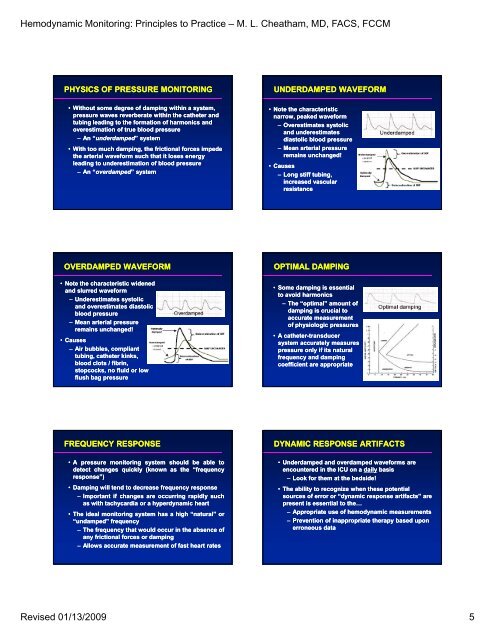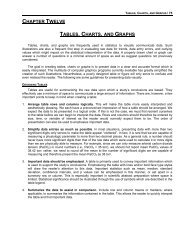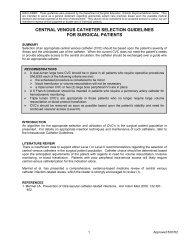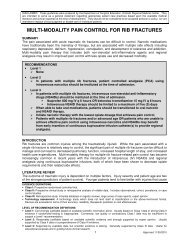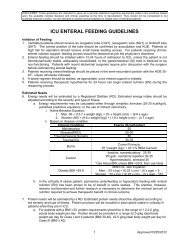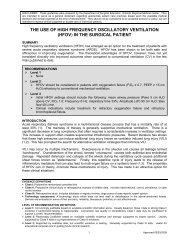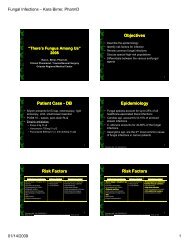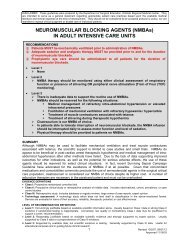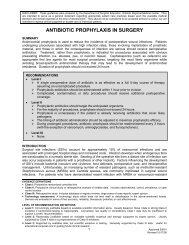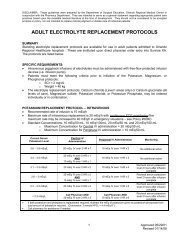Hemodynamic Monitoring: Principles to Practice â M. L. Cheatham ...
Hemodynamic Monitoring: Principles to Practice â M. L. Cheatham ...
Hemodynamic Monitoring: Principles to Practice â M. L. Cheatham ...
You also want an ePaper? Increase the reach of your titles
YUMPU automatically turns print PDFs into web optimized ePapers that Google loves.
<strong>Hemodynamic</strong> <strong>Moni<strong>to</strong>ring</strong>: <strong>Principles</strong> <strong>to</strong> <strong>Practice</strong> – M. L. <strong>Cheatham</strong>, MD, FACS, FCCMPHYSICS OF PRESSURE MONITORING• Without some degree of damping within a system,pressure waves reverberate within the catheter andtubing leading <strong>to</strong> the formation of harmonics andoverestimation of true blood pressure– An “underdamped”” system• With <strong>to</strong>o much damping, the frictional forces impedethe arterial waveform such that it loses energyleading <strong>to</strong> underestimation of blood pressure– An “overdamped”” systemUNDERDAMPED WAVEFORM• Note the characteristicnarrow, peaked waveform– Overestimates sys<strong>to</strong>licand underestimatesdias<strong>to</strong>lic blood pressure– Mean arterial pressureremains unchanged!• Causes– Long stiff tubing,increased vascularresistanceOVERDAMPED WAVEFORM• Note the characteristic widenedand slurred waveform– Underestimates sys<strong>to</strong>licand overestimates dias<strong>to</strong>licblood pressure– Mean arterial pressureremains unchanged!• Causes– Air bubbles, complianttubing, catheter kinks,blood clots / fibrin,s<strong>to</strong>pcocks, no fluid or lowflush bag pressureOPTIMAL DAMPING• Some damping is essential<strong>to</strong> avoid harmonics– The “optimal” amount ofdamping is crucial <strong>to</strong>accurate measuremen<strong>to</strong>f physiologic pressures• A catheter-transducertransducersystem accurately measurespressure only if its naturalfrequency and dampingcoefficient are appropriateFREQUENCY RESPONSE• A pressure moni<strong>to</strong>ring system should be able <strong>to</strong>detect changes quickly (known as the “frequencyresponse”)• Damping will tend <strong>to</strong> decrease frequency response– Important if changes are occurring rapidly suchas with tachycardia or a hyperdynamic heart• The ideal moni<strong>to</strong>ring system has ahigh“natural” or“undamped” frequency– The frequency that would occur in the absence ofany frictional forces or damping– Allows accurate measurement of fast heart ratesDYNAMIC RESPONSE ARTIFACTS• Underdamped and overdamped waveforms areencountered in the ICU on a daily basis– Look for them at the bedside!• The ability <strong>to</strong> recognize when these potentialsources of error or “dynamic response artifacts” arepresent is essential <strong>to</strong> the…– Appropriate use of hemodynamic measurements– Prevention of inappropriate therapy based uponerroneous dataRevised 01/13/20095


